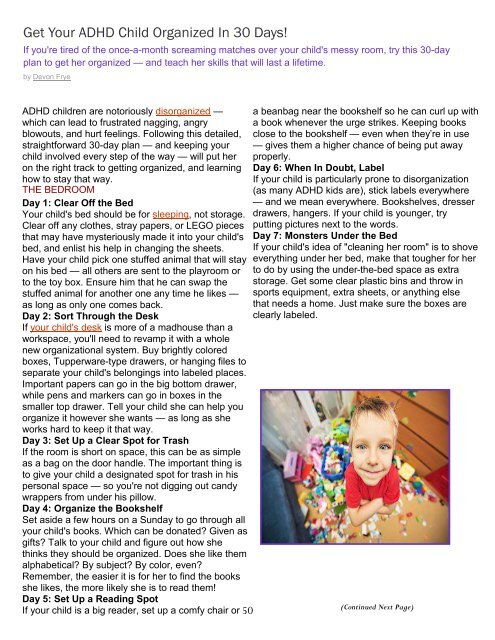June 2016 magazine
Create successful ePaper yourself
Turn your PDF publications into a flip-book with our unique Google optimized e-Paper software.
Get Your ADHD Child Organized In 30 Days!<br />
If you're tired of the once-a-month screaming matches over your child's messy room, try this 30-day<br />
plan to get her organized — and teach her skills that will last a lifetime.<br />
by Devon Frye<br />
ADHD children are notoriously disorganized —<br />
which can lead to frustrated nagging, angry<br />
blowouts, and hurt feelings. Following this detailed,<br />
straightforward 30-day plan — and keeping your<br />
child involved every step of the way — will put her<br />
on the right track to getting organized, and learning<br />
how to stay that way.<br />
THE BEDROOM<br />
Day 1: Clear Off the Bed<br />
Your child's bed should be for sleeping, not storage.<br />
Clear off any clothes, stray papers, or LEGO pieces<br />
that may have mysteriously made it into your child's<br />
bed, and enlist his help in changing the sheets.<br />
Have your child pick one stuffed animal that will stay<br />
on his bed — all others are sent to the playroom or<br />
to the toy box. Ensure him that he can swap the<br />
stuffed animal for another one any time he likes —<br />
as long as only one comes back.<br />
Day 2: Sort Through the Desk<br />
If your child's desk is more of a madhouse than a<br />
workspace, you'll need to revamp it with a whole<br />
new organizational system. Buy brightly colored<br />
boxes, Tupperware-type drawers, or hanging files to<br />
separate your child's belongings into labeled places.<br />
Important papers can go in the big bottom drawer,<br />
while pens and markers can go in boxes in the<br />
smaller top drawer. Tell your child she can help you<br />
organize it however she wants — as long as she<br />
works hard to keep it that way.<br />
Day 3: Set Up a Clear Spot for Trash<br />
If the room is short on space, this can be as simple<br />
as a bag on the door handle. The important thing is<br />
to give your child a designated spot for trash in his<br />
personal space — so you're not digging out candy<br />
wrappers from under his pillow.<br />
Day 4: Organize the Bookshelf<br />
Set aside a few hours on a Sunday to go through all<br />
your child's books. Which can be donated? Given as<br />
gifts? Talk to your child and figure out how she<br />
thinks they should be organized. Does she like them<br />
alphabetical? By subject? By color, even?<br />
Remember, the easier it is for her to find the books<br />
she likes, the more likely she is to read them!<br />
Day 5: Set Up a Reading Spot<br />
If your child is a big reader, set up a comfy chair or<br />
50<br />
a beanbag near the bookshelf so he can curl up with<br />
a book whenever the urge strikes. Keeping books<br />
close to the bookshelf — even when they’re in use<br />
— gives them a higher chance of being put away<br />
properly.<br />
Day 6: When In Doubt, Label<br />
If your child is particularly prone to disorganization<br />
(as many ADHD kids are), stick labels everywhere<br />
— and we mean everywhere. Bookshelves, dresser<br />
drawers, hangers. If your child is younger, try<br />
putting pictures next to the words.<br />
Day 7: Monsters Under the Bed<br />
If your child's idea of "cleaning her room" is to shove<br />
everything under her bed, make that tougher for her<br />
to do by using the under-the-bed space as extra<br />
storage. Get some clear plastic bins and throw in<br />
sports equipment, extra sheets, or anything else<br />
that needs a home. Just make sure the boxes are<br />
clearly labeled.<br />
(Continued Next Page)



